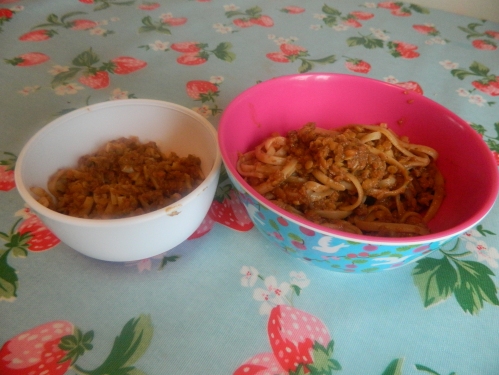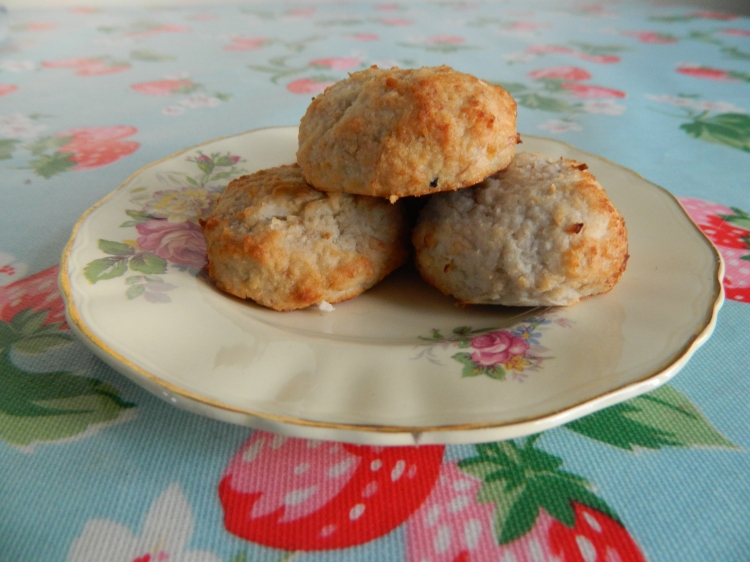What’s for lunch*: “Best ever spag bol” with chicken livers
I dithered over posting this recipe, as I know people have a bit of an “ewww” reaction to liver. But logically, if you’re happy to eat a chicken’s legs why not it’s liver?
I made it last week for lunch, it’s really tasty and nutritious and the babster loved it, I gave a little taster bowl to my eldest daughter (who’s 7) and she didn’t like it, I can’t really expect her to as I’ve never gave her chicken liver, so it’s not a flavour she’s used to (the dish isn’t overly liver tasting anyway – if that makes sense). Forcing children to eat food is a very bad idea, getting them to try a little bit of everything is the ideal.
Anyway, please keep an open mind and try it, it’s Jack Monroe’s spaghetti bolognese recipe posted her blog last week, – it’s adapted from a recipe in Jamie Oliver’s latest cookbook. I didn’t include was the chilli (for obvious reasons) or the spinach because it’s not in season at the moment so is flown in from Spain. I used organic chicken livers and I slightly adapted it by not using chilli for obvious reasons or frozen spinach – because I didn’t have any.
Ingredients
1 carrot peeled top and tailed and sliced
1 onion sliced
2 fat cloves of garlic crushed
1tbsp olive oil
200g chicken livers
1 teaspoon of mixed herbs
1 tsp fennel seeds
390g carton of chopped tomatoes,
1 tbsp vinegar – red wine or white wine
100g red lentils
100g spaghetti
Heat the oil in a heavy bottomed sauce pan and add the onion, carrot and garlic.
Add the vinegar, herbs and fennel. Rinse the livers and toss them in too.
Fry everything together on a medium-high heat for 5 minutes until the veg softens and the livers are sealed.
Carefully put the veg and livers into a blender with the chopped tomatoes, and blend until fairly smooth.
Pour the contents of the blender back in the pan on a medium heat, and add 200ml water, and stir well.
Rinse the lentils well and add to the pan.
Add a little more water if the sauce starts to dry out
Bring a pan of water to the boil and add the spaghetti to cook.
The bolognese mixture should take about 15-20 minutes to cook – the lentils should be soft.
Drain the pasta, toss the sauce through,and top with cheese to serve.
Portion sizes
These portion sizes are based on Caroline Walker Trusts Chew guidance for the first year of life and 1-4 year olds.
7-9 months : 60g bolognese to 50g pasta plus about 20g of vegetables as finger food (for this age range you can blend the bolognese and pasta together with a little of baby’s usual milk)
10-12 months : 80g bolognese to 50g pasta plus 30g vegetables as finger food (for this age range you can blend/chop the pasta to make it easier to eat)
1-4 years : 90g bolognese to 80g pasta plus 40g vegetables
Nutrition bits
Based on the above portion sizes for a 10 month old ,this dish would provide about a quarter of their daily recommended intake for iron and magnesium, 3 times their recommended Vitamin A , nearly half their recommended Vitamin B1 intake, three quarters of their Vitamin b2 intake, just under a third of their recommend B3, half their recommended B6, all their recommended folate and vitamin B12 intakes.
Dairy, egg and gluten free
If you can easily exclude these allergens if you use pasta made from rice and/or quinoa – these pastas are usually egg free too, but check the label just in case.
*What’s for lunch is a series of posts with lunch ideas and recipes for you to share with your baby and/or toddler. Sharing the same food is all part of the social aspect of mealtimes and you’re children learn about food and eating from eating you…




